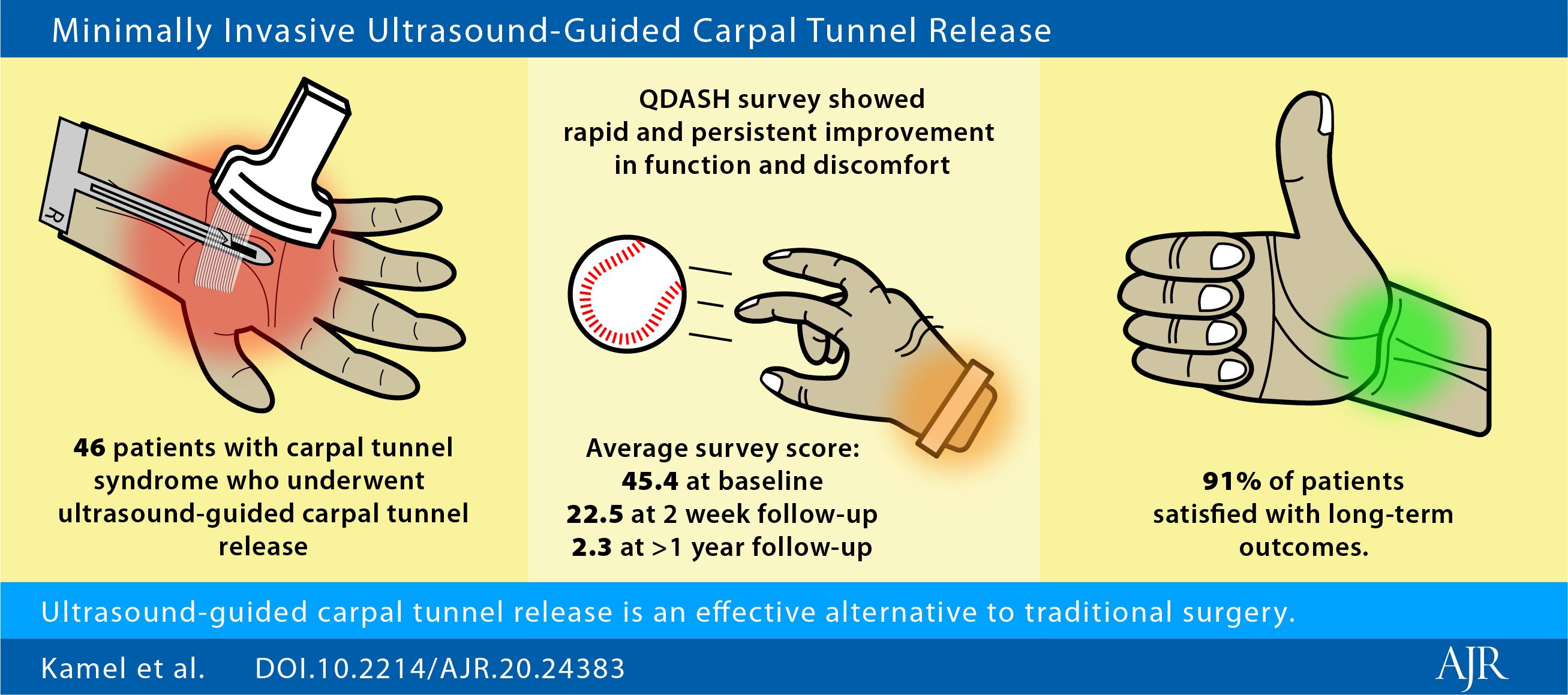Ultrasound Guidance Offers Quicker Relief and Better Function After Carpal Tunnel Surgery
Minimally invasive ultrasound-guided carpal tunnel release offers faster and longer-term relief from carpal tunnel syndrome.
Ultrasound guidance makes carpal tunnel release surgery not only safer and less invasive than traditional open or endoscopic surgeries, but it also leads to quicker improvements in hand function and discomfort, according to newly published research.
Ultrasound-guided carpal tunnel release (UGCTR) uses smaller incisions and provides a quicker recovery, so researchers from Thomas Jefferson University Hospital investigated what the long-term implications of this technique might be. They found patients had sustained improvements at approximately one year post-surgery.
They published their results in the Sept. 17 American Journal of Roentgenology.
“Our study demonstrates that ultrasound-guided carpal tunnel release can be performed safely, with high patient satisfaction and significant long-term relief of [carpal tunnel syndrome],” said the team led by Sarah I. Kamel, M.D., assistant professor of radiology. “The rapid post-operative recovery and longstanding relief of symptoms suggest that ultrasound-guided carpal tunnel release may be advantageous to traditional surgical methods of transverse carpal ligament transection.”
To determine how well UGCTR works, Kamel’s team retrospectively reviewed the results of the procedure performed on 46 patients (61 wrists total) that were referred to their clinic between July 2017 and April 2019. All surgeries were performed by the same provider, under local anesthesia in an outpatient setting, and using the same procedure equipment (SX-One MicroKnife®).
Courtesy: American Journal of Roentgenology

As a way to judge the outcomes, the team had patients fill out three questionnaires designed to assess their hand’s pain and function levels – the Quick-Disabilities of the Arm, Shoulder, and Hand (QDASH), the Boston Carpal Tunnel Syndrome Questionnaire symptom severity scale (BCTSQ-SS), and the BCTSQ functional status scale (BCTSQ-FS). The provided answers pre-procedure, two-weeks post-procedure, and after 1.7 years with higher score indicating greater discomfort.
According to their responses the median pre-procedure scores here 45.4 for QDASH, 3.2 for BCTSQ-SS, and 2.5 for BCTSQ-FS. After two weeks, scores had fallen to 22.5 for QDASH, 1.7 for BCTSQ-SS, and 1.9 for BCTSQ-FS. And, at the final check point, for the 90 percent of participants who could be contacted, scores had plummeted – 2.3 for QDASH, 1.2 for BCTSQ-SS, and 1.1 for BCTSQ-FS. Overall, 96 percent of wrists ultimately had lower QDASH scores, as did 98 percent for BCTSQ.
No patients experienced immediate complications, but two patients required follow-up surgery within 8-to-10 days after the first procedure. To avoid those outcomes in the future, the team made two adjustments. They now include more extensive pre-procedural cleaning that extends around the forearm prior to draping, and they perform two passes of the ligament transection to potentially decrease the risk of remnant tissue that may contribute to incomplete release.
These results, the team said, these results point to the efficacy of the UGCTR procedure, but future longitudinal investigations into follow-up and cost analysis are necessary.
“Ultrasound-guided carpal tunnel release quickly improves hand function and reduces hand discomfort, with persistent improvement at one year,” the team said. “Ultrasound-guided carpal tunnel release may be a safe, effective and less invasive alternative to traditional open or endoscopic surgery, particularly in patients for whom traditional surgery may be high-risk or contraindicated.”
The Reading Room: Racial and Ethnic Minorities, Cancer Screenings, and COVID-19
November 3rd 2020In this podcast episode, Dr. Shalom Kalnicki, from Montefiore and Albert Einstein College of Medicine, discusses the disparities minority patients face with cancer screenings and what can be done to increase access during the pandemic.
Study: AI Boosts Ultrasound AUC for Predicting Thyroid Malignancy Risk by 34 Percent Over TI-RADS
February 17th 2025In a study involving assessment of over 1,000 thyroid nodules, researchers found the machine learning model led to substantial increases in sensitivity and specificity for estimating the risk of thyroid malignancy over traditional TI-RADS and guidelines from the American Thyroid Association.